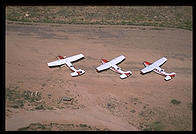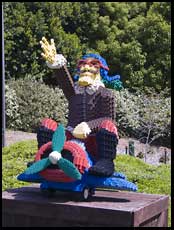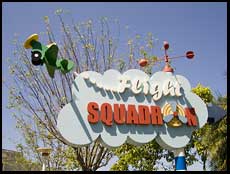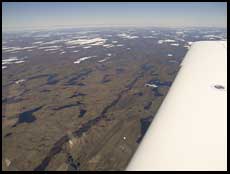

|
Learning to Flyby Philip Greenspun, CFI, CFII |
 In getting a single-engine private pilot's certificate, you have to pick
three things:
In getting a single-engine private pilot's certificate, you have to pick
three things:
Worried about safety? Statistics show that the Cessna 172 and the Diamond Katana are about the safest trainers. The Cessna 150/152 and the Piper Tomahawk have combined with student pilots to assemble comparatively poor safety records.
How about noise? The Katana isn't any bigger than it needs to be, which means that it can cruise at 104 knots with an 80-horsepower engine. The Cessna 152 needs 110 hp and the Cessna 172 needs 160 hp to cruise just a bit faster. Less horsepower means less noise. The Katana is one of the only single-engine airplanes in which I find the noise tolerable without noise-cancelling headphones.
Visibility through the Katana's plastic canopy is much better than older-design airplanes with their windshields, support bars, metal roofs, etc.
You'll never get killed in a Katana by a 25-year-old part that finally wears out; the airplanes have only been produced since the mid-1990s.
The main drawback to a Katana is space. At 6' tall and 195 lbs., I just barely fit into the machine. If my instructor were as fat as I am, we'd have to dump some fuel in order to get off the ground. If I wanted to bring the dog along on a flight, there isn't a back seat in which he could safely ride.
Finally there is an emotional element. If the old Cessnas and Pipers at most schools remind you of Volkswagen Beetles with wings, it isn't an accident. They were designed at around the same time as the old VW! The Katana looks more like the modern kit planes that your cousin might have built in his garage, but finished to a vastly higher standard.
(If you believe in the wisdom of government, you can follow the example of the United States Air Force. After an extensive evaluation of trainers, the USAF Academy decided to use the latest Continental-powered DA20s for all of their primary flight training. The US Naval Academy also uses the DA20.)
 Most people working as flight instructors are folks anxious to get their
Air Transport Pilot (ATP) certificates but not anxious to pay for 1,500
hours of airplane rental. Such an instructor may not necessarily have a
great love of teaching, and if you can't complete your training in three
months or so, you might find that your instructor has moved on to a job
at the local commuter airline. In theory it should be much better to
find an instructor who has 3,000+ hours and is teaching because he or she
likes to teach. However, someone who has been an expert pilot for
decades may not be able to understand what you're doing wrong or explain
step-by-step how to do maneuvers. The expert pilot has deep knowledge
in his or her bones and muscles. That is tough to transfer. By
contrast, you might learn more from an articulate newer pilot than an
older expert who is able to show, but not explain, how it is done.
Most people working as flight instructors are folks anxious to get their
Air Transport Pilot (ATP) certificates but not anxious to pay for 1,500
hours of airplane rental. Such an instructor may not necessarily have a
great love of teaching, and if you can't complete your training in three
months or so, you might find that your instructor has moved on to a job
at the local commuter airline. In theory it should be much better to
find an instructor who has 3,000+ hours and is teaching because he or she
likes to teach. However, someone who has been an expert pilot for
decades may not be able to understand what you're doing wrong or explain
step-by-step how to do maneuvers. The expert pilot has deep knowledge
in his or her bones and muscles. That is tough to transfer. By
contrast, you might learn more from an articulate newer pilot than an
older expert who is able to show, but not explain, how it is done.
The only way to evaluate an instructor is to ride with him or her. If the instructor touches the controls before the final approach to land, that's bad. A good instructor should be able to talk you through every maneuver and should have the patience to let you fly the airplane badly. You should never be afraid. The instructor should take you into progressively more challenging situations so gradually that you barely feel the challenge. The instructor should try to teach only one thing at a time. As a beginner you may be doing ten things wrong at any given time. A good instructor will pick one out of the ten to talk about and tactfully ignore your other nine mistakes.
In terms of the number of hours required to get your certificate, it might be most efficient to fly with a single superb instructor. But I flew with five different people in the right seat during my first 20 hours and learned unique and valuable lessons from each one. If you're having trouble with a maneuver, fly with a different instructor and get a fresh explanation of how to do it and a fresh perspective on what you're doing wrong. If you're worried that you're going to miss something by bouncing around from instructor to instructor, pick up a Jeppesen training syllabus and organize your own learning around it.
Finally, find instructors whose company and conversation you enjoy. You're going to have some long cross-country flights and a lot of one-on-one time waiting for planes, resting between lessons, eating lunch, etc. It might as well be enjoyable time. If it means that you need five more hours to get your certificate, at least you were having fun during those five hours.
 The best pace for learning to fly is probably the same pace at which you
intend to fly recreationally. Human memory requires periodic
reinforcement, ideally at roughly the intervals when you're 50 percent
likely to recall (or forget). Suppose that you're able to remember
random facts for about one month. You go down to Arizona where more than
350 days per year have good enough weather for visual flight rules
(VFR). You train every day for three weeks and get your certificate.
You go back home to New England and, due to work, social commitments,
and bad weather, fly just once a month. By the time you're forgetting
the stuff that you've learned, you're up in an airplane with no
instructor.
The best pace for learning to fly is probably the same pace at which you
intend to fly recreationally. Human memory requires periodic
reinforcement, ideally at roughly the intervals when you're 50 percent
likely to recall (or forget). Suppose that you're able to remember
random facts for about one month. You go down to Arizona where more than
350 days per year have good enough weather for visual flight rules
(VFR). You train every day for three weeks and get your certificate.
You go back home to New England and, due to work, social commitments,
and bad weather, fly just once a month. By the time you're forgetting
the stuff that you've learned, you're up in an airplane with no
instructor.
I personally opted to train three days per week and felt it was about as fast as reasonable, given the amount of reading and studying that I wanted to do in between lessons. Note that the period of time in which your probability of recall falls to 50 percent gets longer after you've been reminded a few times. Maybe you learned a VFR rule and forgot it the next day but were reminded by your instructor. It may take a week before your memory degrades to the point of 50 percent probability of correct recall. After another reminder, the next time interval might be a month. Thus it may make some sense to train intensively for a month or two and then reduce the frequency of lessons if flight training is interfering with the rest of your life. On the other hand, once you've done all the reading and simply need to build up your coordination skills, it may make sense to fly all day every day for a few weeks.
 Between airplane rental, instructor time, and the various accessories
that you'll want to buy, budget about $10,000 to get your private pilot
certificate. If you figure that you'll get your certificate at 70 hours
of flight time, budget 280 hours to build up those 70 hours. The
four-to-one ratio accounts for time spent driving to the airport,
waiting around for the airplane and instructor to be available,
preflighting the airplane, putting the airplane away, paying your bill,
and driving home. Budget another 100 hours for reading textbooks,
studying rules and regulations, browsing Internet sites, talking to
experienced pilots, etc. If you're a full-time wage slave, flying will
be your only hobby for a while.
Between airplane rental, instructor time, and the various accessories
that you'll want to buy, budget about $10,000 to get your private pilot
certificate. If you figure that you'll get your certificate at 70 hours
of flight time, budget 280 hours to build up those 70 hours. The
four-to-one ratio accounts for time spent driving to the airport,
waiting around for the airplane and instructor to be available,
preflighting the airplane, putting the airplane away, paying your bill,
and driving home. Budget another 100 hours for reading textbooks,
studying rules and regulations, browsing Internet sites, talking to
experienced pilots, etc. If you're a full-time wage slave, flying will
be your only hobby for a while.
Maintain a sterile cockpit (no chatting with anyone else in the plane) when taxiing, at least if you're anywhere near hangars and other airplanes. If you are going to hit something with your plane, it will very likely be when taxiing.
 Don't look at your instruments and adjust the flight controls, for
example, to keep the altimeter steady. The instruments have a tendency
to lag behind reality, and therefore if you "chase the instruments" by
adjusting the flight controls, you will overcorrect and oscillate.
Staring at your instruments is also a good way to get motion sickness.
Use the flight controls to keep the nose of the airplane at a constant
attitude relative to the horizon. After you've got that attitude
established, glance at your instruments to see if the chosen attitude is
giving you what you want (level flight, climbing, a descending turn,
whatever). If not, set a new attitude for the nose relative to the
horizon and look at the instruments again a few seconds later. In VFR
flight the primary instrument is the nose's position relative to the
horizon.
Don't look at your instruments and adjust the flight controls, for
example, to keep the altimeter steady. The instruments have a tendency
to lag behind reality, and therefore if you "chase the instruments" by
adjusting the flight controls, you will overcorrect and oscillate.
Staring at your instruments is also a good way to get motion sickness.
Use the flight controls to keep the nose of the airplane at a constant
attitude relative to the horizon. After you've got that attitude
established, glance at your instruments to see if the chosen attitude is
giving you what you want (level flight, climbing, a descending turn,
whatever). If not, set a new attitude for the nose relative to the
horizon and look at the instruments again a few seconds later. In VFR
flight the primary instrument is the nose's position relative to the
horizon.
You can fly all day midair without using the airplane's rudder. Maybe not super efficiently but you can get where you want to go using only the ailerons and elevators. Landing is different, especially a crosswind landing. The rudder becomes a critical tool in keeping the airplane on the runway centerline and for making sure that the tires are pointed in the direction of aircraft movement so that the gear aren't side-loaded during touchdown. On short final, press relatively hard on both rudder pedals. Mostly your left foot is fighting off the pressure from your right. But at least you are consciously working the rudders and, when necessary, will push decisively in the required direction.
There are two things that are hard about landing. One is flying the airplane at landing speed with the wheels just over the runway. Two is flying the airplane just below landing speed with the wheels on the runway. You might say that item two isn't flying but rather taxiing. But in point of fact the ailerons and rudder are still functioning as control surfaces for keeping the plane headed down the centerline. Let's suppose that you do 10 touch-and-gos. How much practice will you get in these two regimes of operation? Maybe 20 seconds (10x2) of flying low over the runway and 40 seconds (10x4) of rolling down the runway really fast after landing. Landings are quick. I didn't learn anything from my first 20 except that the airplane was always in the wrong place and that my instructor tended to start yelling about 10 feet above the ground.
My friend Richard came to the rescue. He suggested that I go up to the Pease tradeport in New Hampshire. The runway at this former military base is more than two miles long (11,300', longer than Logan Airport's longest runway!). Richard suggested trying to fly the entire length of the runway with the wheels just above the centerline, then coming back to land and roaring down the entire remainder of the two-mile runway at 50 knots without lifting the wheels. "Ask for clearance for the 'option' when doing the low flight," Richard noted, "and tell the tower that you want to practice aborted takeoffs for the long taxis."
This was the key. After about 90 minutes of playing around on the Pease runway, I felt confident in my ability to control the airplane on or near the ground at or near landing speed. All this with an instructor I'd never flown with before. Final score: six complete landings with no instructor assistance against one landing where the instructor needed to push the controls a bit. The instructor, Lara Greenwood, noted that the easiest way to land a plane was to try not to land. She said "if you just try to float along the runway as low as possible without landing, eventually you'll sink down onto the runway in more or less the correct attitude." And she was quite right! My best landings were after the long floats. When I concentrated on landing, I would flare too much or too little.
More: Make Better Landings (Alan Bramson; 1982; out of print but probably easy to find on the Web, a revised edition from 1994 is supposedly available from amazon.com)
The foregoing notwithstanding, Microsoft Flight Simulator (MSFS) is an excellent program, and it might make you feel more comfortable that you can handle unusual situations. If you do set up MSFS, try to do it on a computer with two monitors so that you can open one window on the bottom or side for the instruments and reserve the main monitor for the view over the cowl. My instrument-rated friends report that MSFS was tremendously valuable in learning instrument flying.
Here's what you need for a good home simulator:
If you don't mind spending some extra time and money, you could defer studying for the knowledge test until shortly before your checkride. Then you won't have to study twice. Again, however, you'll probably want the course from www.kingschools.com.
(Personal results: I used King Schools courses for Private, Instrument, and Commercial knowledge tests. My scores were 97, 98, and 100 respectively.)
Another resource is joining Airline Owner's and Pilot's Association (www.aopa.org). Membership is free for student pilots.
Flight training hasn't changed for 50 years. Chances are your question has already been asked, answered, and indexed in one of the aviation newsgroups such as rec.aviation.student. Check http://groups.google.com/ before posting a duplicate!
Food for thought:
Oh yes, be sure to carry a barf bag for any passengers. In the immortal words of Charles Wright, instructor at East Coast Aero Club, "Having a passenger throwing up violently a few inches from you can be very distracting."
Nearly all Air Force fighter pilots succumb to motion sickness during their training, which of course involves aerobatics. The Air Force does not wash out those students who throw up. If a pilot throws up and then is able to continue the mission he or she is considered a good pilot. It is the pilots who throw up and remain incapacitated who are washed out. The good news is that nearly all Air Force pilots develop a tolerance for aerobatics and stop throwing up. The bad news is that if a pilot doesn't fly for a month or so the tolerance is lost.
Personally I found that motion sickness was less of an issue at 50 hours than 5, less at 100 than 50, and barely a memory at 200 hours. The only way that I can bring on any symptoms is to let a friend fly through bumpy skies while I dig through luggage in the back of the airplane. The foregoing notwithstanding, I still try to avoid turbulence because I find it wearing and uncomfortable.
MSFS is very nice, but is made to be more of a game than a simulator. Try X-Plane too -- it has a very good (and getting even better) flight model and an great amount of work has been put into realism, including the ability to fail any of the airplane's systems to see how you can recover. It has been used for generic (not specific to a single airplane model) full-motion simulators (these people are just building full size cockpit with X-Plane).
You are right in the fact that you can't really compare a simulator to the "real thing" because you can't look around, but it does seem to help. I only flew once so far (introductory flight), and the instructor kept his apendages off the controls for most of the flight (he did the final landing, though). He didn't believe me when I told him that I never flew an airplane before.
-- Petru Paler, January 5, 2002
I agree with Phil's observations here. Trying to fly 2-3 times a week works out less expensive and faster in the long run - assuming time to read and study between flights. Especially when, say, 3 planned flights a week might actually end up being 1 or 2 depending on weather and other last minute problems (plane hasn't returned from the previous person, instructor called in sick, etc., etc.). This is especially true when you start doing cross country flights.
Other things I found useful were:
- flying early. This won't be for everyone, but I liked lessons at 6-6:30am. The plane was always available and usually fueled, the instructor wasn't running late from another lesson. There was no/little traffic in the pattern and on the field - providing more time flying and less time taxiing or extending downwind. And the air was usually calm and cool - great while you're still starting out. Of course I still flew at other times of the day, but I loved those early mornings.
- Plan your own lessons. You may get an instructor who plans for you, but if my experience was typical, the instructor will more or less randomnly decide what to practice while doing pre-flight with you. I quickly found I could get *much* more out of a lesson if I proposed the activities for the day. E.g. 'before we do circuit work, can we do some steep turns? I'm not happy with how I handled them the other day'. or 'Could we work on short-field landings today as its been a while?'. Also, at the end of each lesson I would ask 'What do you think I should work on next lesson?'. I found that the instructor's response was usually much more appropriate then, after spending an hour or so in the cockpit with me, than just before the next lesson.
- William Kershner's Student Pilot's Flight Manual. For some reason this book hit a chord for me. I found the explanations really helpful and the practical techniques worked well. I read many many books while learning to fly, but this is the one I ended up using as my reference.
- Take the written early. Of course some schools require this. Mine didn't but I went ahead and did it after only about 15 hours of instruction. I found I benefited from this in many ways, and when the topics came up again in actual training I was able to get much more from them.
- 'Fly' while parked. It doesn't cost anything to sit in the plane on the ground, so if you can, turn up early for your lesson and run through the day's procedures while sitting in the plane (with everything off). While this is especially good for checklist procedures, I also found it useful for steep turn practice, cross control practice (e.g. slips), stalls and other manouvers.
- Try other instructors. I couldn't agree with Phil more on this - especially if you're blocked on something. E.g. I just couldn't get my Taylorcraft to touch down softly - until I flew with another instructor who suggested holding the yoke just between my thumb and forefinger. Magic! The T'craft was just SO much more sensitive than the Cessna 150 I'd been flying previously (that plus the bungie cord landing gear).
- Get some controlled field time early. I admit it - I had my Private's license and almost 250 hours before I really did any controlled airpot flying - and I was scared of screwing up! My lessons weren't at a controlled field and I only went into one once during training. If I was starting over, I'd insist on going to a nearby controlled field until I was truly comfortable with the radio procedures. The irony was, of course, that once I got used to it it was actually easier than an uncontrolled airport - albiet less convenient at times.
- Cut your lesson short if need be. Some days I just couldn't get my head into whatever skill I was learning. My instructor did me a favor and taught me to quit while I was ahead and/or before I learnt bad habits by trying more. It saved me money, gave me a chance to go home and study the manouver more, and generally the next time I flew it would all fall into place.
I hope these tips are useful...
-- Michael Mee, February 10, 2002
FlightGear Image of DC-3 Departing KSJC
Check out what the talented developers of the open-source flight simulator FlightGear http://www.flightgear.org have produced. I consider it one of those great open source success stories like the Apache webserver - only no one's heard of it...yet!Cheers,
Mark Turner
-- Mark Turner, February 11, 2002
Some of the downsides of the Katana as a trainer:1) It is considerably more expensive to rent, per hour, than a typical 150/2 or Tomahawk (both of which are excellent learning platforms). Hello, money matters.
2) The thing doesn't fly or, especially, land like almost any conventional airplane in the GA fleet. That's because it's a quasi-glider. It floats, a lot. Most private pilots will transition from trainers to middle-of-the-road Cessnas (172s) or Pipers (Cherokees); the more adventuresome and well-heeled will go the way of Mooneys, Bonanzas, etc. (No one without a good bit of experience should think about getting into a Lancair or something like that -- wonderful, wonderful airplanes, but they are decidedly high-performance and need an experienced stick.)
And that's why Cessnas and Pipers -- and primarily Cessnas -- still dominate the training fleet. Why spend almost twice as much on a Katana when you're going to have to relearn so much in transitioning to 99.5% of what's out there?
I suppose what bugs me about this flying section is that it is written by someone who took the 'golden road' to learning and treats that experience as if it's ordinary or even necessary. Having learned how to fly as a teenager in a Champ, paying as I went along by mowing lawns and what-not, this talk of Sennheiser headsets and $80/hr+ aircraft rentals is just plain silly.
We need to encourage young pilots and take into account the fact that young pilots -- and, for that matter, most pilots -- are not wealthy dot-com types. I fly far nicer ships these days, but the basics are the basics.
-- george day, May 2, 2002
I learnt to fly in San Diego in 1997. It took my 25 hours and 119 landings to go solo, and 55 hours total until I took my test over a period of 5 months. From talking to other people this is about average. I wrote down everything on spent on learning to fly in the back of my logbook, and the total came to $4650. In term of planes I would tend to recommend the 172 or Cherokee. They both cost a bit more than the 152 or Tomahawk, but are more stable, and more comfortable which helps keep the hours down. Later I learnt alpine flying ;while working in Switzerland; in a Katana and would thoroughly recommend the Katana. The visibility from the cockpit and the improved performance and feel over a Cessna 152/172 made flying more enjoyable for me.I would recommend using several instructors and different airfields, pay per hour, and never block buy hours. You can stick with a good instructor until you come up against a block in your learning, but then it is best to switch staight away. These guys will sit with you all day even if you are not learning anything, most are motivated just to build hours.
Passing the test doesn't make you a good pilot and you need a lot more hours to build confidence. Keep well within your limits for the first few hundred hours. If you get over confident and encounter a bad situation you can scare yourself out of flying forever.
Try to have a clear idea what you want to do with your flying after you pass the test. My plan was that as I travelled the globe working on short term contracts I could fly in different countries; and I did this in Belgium, Switzerland, Australia and Kenya. However, I since stopped flying as I no longer find it enjoyable having to go through all the requirements to fly and hire planes in each country. I hope I can get back to it if I stay in one place for a while.
-- Mike Bulcock, July 28, 2003
I flew a "discovery flight" in a Cessna 172, and my lessons have been in a Katana. Both planes were relatively new. (My school doesn't keep them more than 3 or 4 years, tops.)The Cessna was enough to put me off flying. It was like a rickety old schoolbus. I didn't feel like I was "flying" so much as "making vague suggestions to the airplane", which it would take under advisement and possibly obey when it got around to it. The Katana does what I tell it to do.
I guess there are cheaper ways to fly. I pay $90 for a nearly new Katana. But their Cessna is $120 per hour. (Gotta love that $4 per gallon avgas.) I could save a little by finding a "school" with a tired old 152, but I wouldn't enjoy it as much...and since I'm only in it for the fun, enjoyment is everything. The lessons ARE my hobby, not just something I have to endure in order to start a hobby.
I like the Katana. It is what it is, though. It's not a cargo plane, by any stretch. And, at 6'3", a couple of hours in the cockpit is all I can tolerate. It's clearly not the plane I'd want to own in the long term, but for learning purposes it's great.
-- Eric Anderson, July 4, 2006